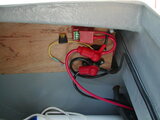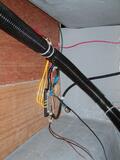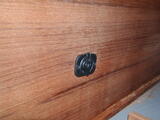This "general wiring" page is badly in need of update. Most of the entries here were written in 2002 when a minor rewiring was done mostly to clean up the poor job from the factory (undersized wire and non-standard colors), add wiring to 12V sockets, add a wiring to the masthead for the anchor light and light on the masthead fly, and run heavy wire to the inverter.
In 2005 we did a major rewiring. The 255AH 8D battery was added. The fuse arrangement was changed with a switch shutting off all of the loads and a new circuit for the trolling motor. The charge side was completely upgraded with a socket for the water towed generator, the charge controller in the cabin, a voltmeter and two ammeters in the cabin, a FogMate (tm) to allow automatic horn signals in the fog, and circuits for two solar panels. All charge sources have their own rectifier and fuse.
The color coding used by Compac differs from ABYC standards. The rewiring uses different wiring color conventions than Compac that are almost identical to the ABYC standards.

When the first rewiring was done in 2002 the outboard provided the only good means to quickly put some charge into the battery. The outboard was an inconvenient charging source and a poor solution to the problem of battery charging. The lack of a good charging source wasn't corrected until 2005.
The cables provided with the outboard did not reach the battery eliminating this charging source for the 2001 season. Posts to attach the outboard cables, plus cable, connectors (lugs), and fuse assembly were installed. The posts are located such that they are near the battery. The outboard has been sold but the posts are still used as a major junction of for the power and ground of major loads.
Since the photo to the left was taken, the wiring in this area has become more crowded with the addition of wiring for the inverter and the trolling motor both served by 4 gauge wire. This wiring is on the port side inside the cockpit locker. The charging wiring is on the starboard side inside the cockpit locker. Updated photos are needed.
NEED PHOTO
All of the loads except the bilge pump are now connected through a single battery switch, providing one place to shut everything off.
NEED PHOTO
The bilge pump came with a circuit breaker on the switch. It now has a fuse in addition to the breaker. The breaker is likely to be rated lower than the fuse so in the event of a jammed pump, the breaker should trip rather than the fuse blow. The fuse is close to the battery (just off the power posts) and provides additional safety in case the switch or breaker failed or there was a wiring short.

The ground wiring was also greatly improved. The photo was taken in 2002. The lower 4 gauge wire in the photo goes to the distribution post in the port side cockpit locker where the battery is directly connected. Individual ground circuits are attached at the terminal strip. A second 4 gauge wire goes through a hole and forward into the cabin. Just over half way through the cabin the second 4 gauge wire wire ends at another terminal strip just over the fresh water tank. This second ground distribution serves the foreward navigation lights, all lights on the mast, the cabin lights, and the fixed mount VHF. Rather than pull individual 14 gauge ground wires for each circuit, this single heavy ground wire reduces voltage drop.
The green wires and the smaller black wires in the photo are Compac's navigation light wiring. The navigation light wiring was also later replaced, colored according to the ABYC standards (grey), and run more directly.
New photos are needed. The ground wiring has remained essentially the same with two heavy duty ground distribution terminal strips connected to the battery and to each other with 4 gauge black battery cable and using yellow 10 to 14 gauge for the individual ground wires.

Two 12V electric sockets have been installed. These required a 1-1/8 inch drill bit which was purchased specifically for this job. Accesory wires are normally done in orange, so the wiring is orange. There is currently an ACC fuse and switch which was previously unused and is now used for these sockets. The fixed mount VHF was later added to the cabin circuit.
![]() Previous Page: New sails and reef points
Previous Page: New sails and reef points